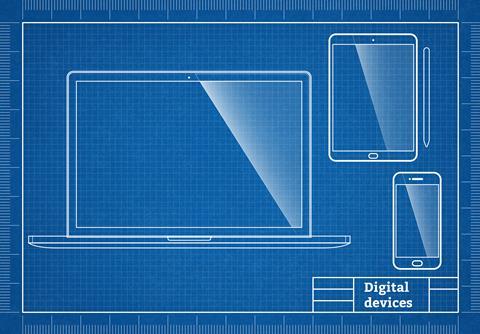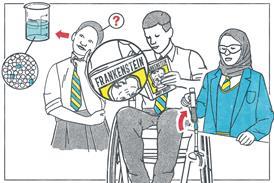How are other teachers using digital devices in STEM subjects post-pandemic?

When the UK and Ireland entered lockdown in March 2020, teachers faced an unprecedented challenge. Necessity became the mother of invention, particularly for STEM educators where visualisation is crucial. But what lasting impact has this digital revolution had on our classrooms?
Lewis Edwards Yates, a chemistry and maths teacher, found a simple but effective solution. He now projects his Samsung Galaxy tablet via Google Meet onto the class display, giving him freedom to circulate and check on learning. ‘Apparatus drawing is much clearer than drawing from scratch on a whiteboard,’ he explains. At the tap of a stylus, he can annotate PDFs and switch to apps such as PhET and GeoGebra.
Other teachers adopted similar approaches, Rob Murray-Green, head of XL Academy at Ashton Sixth Form College, uses his personal iPad for creating YouTube content and digital notes. And Niall Begley, a chemistry teacher in Belfast, embraces the benefits of apps like OneNote.
The numbers tell the story of this rapid transformation. According to a 2022 House of Lords report, 64% of schools have upgraded their IT provision since the pandemic, while 80% have improvised with old and new equipment. UK schools now spend an estimated £900 million annually on digital technology.
‘It’s great for certain situations or to support pupils with SEND/ASN’
Assistant head David Paterson is a firm believer in the benefits of embedding student digital devices into the classroom. Some colleges have embedded digital tools into policy. At Hills Road Sixth Form College in Cambridge, a bring your own device (BYOD) policy requires all STEM students to bring tablets and styluses. The University of Liverpool Maths School has similar BYOD approach, while also loaning iPads to students who need them.
However, BYOD remains the exception. Heads of chemistry at four sixth form colleges in northwest England reported that fewer than 4% of 16–19 year-old students used tablets and styluses in class. However, Cath Wood at Aquinas College, Stockport, noticed tablet and stylus usage increased to 30% during exam season. Ashley Aitken, teaching in Glasgow during the £700 million iPad rollout in 2019, witnessed immediate benefits: ‘Initially pupils were very engaged … we also had AppleTV in every room so young people could connect their iPad to the whiteboard screen. It helped literacy enormously.’
Other teachers adopted similar approaches, Rob Murray-Green, head of XL Academy at Ashton Sixth Form College, uses his personal iPad for creating YouTube content and digital notes. And Niall Begley, a chemistry teacher in Belfast, outlines the benefits of apps like OneNote (rsc.li/4qUo9Bn).
The numbers tell the story of this rapid transformation. According to a 2022 House of Lords report, 64% of schools have upgraded their IT provision since the pandemic, while 80% have improvised with old and new equipment (pdf: bit.ly/47jS1FC). UK schools now spend an estimated £900 million annually on digital technology.
Assistant head David Paterson summarises the benefits of embedding student digital devices into the classroom (rsc.li/3WLkBuK). Some colleges have embedded digital tools into policy. At Hills Road Sixth Form College in Cambridge, a bring your own device (BYOD) policy requires all STEM students to bring tablets and styluses (bit.ly/43mD7NG). The University of Liverpool Maths School offers similar BYOD, while also loaning iPads to students who need them.
However, BYOD remains the exception. Heads of chemistry at four sixth form colleges in northwest England reported back that fewer than 4% of 16–19 year-old students used tablets and styluses in class. Cath Wood at Aquinas College, Stockport, noticed tablet and stylus usage increased to 30% during exam season. Ashley Aitken, teaching in Glasgow during the £700 million iPad rollout in 2019 (bit.ly/47wb1eD), witnessed immediate benefits: ‘Initially pupils were very engaged … we also had AppleTV in every room so young people could connect their iPad to the whiteboard screen. It helped literacy enormously.’
The key to the challenges: access
The Glasgow rollout also revealed problems. Ashley recalls losing control as pupils ‘began to Wi-Fi hotspot from their mobile devices’. Despite school policies, a Teacher Tapp poll found 60% of secondary teachers caught students using phones inappropriately when they should be out of sight.
‘We have 15 old, slow laptops with missing keys’
The Glasgow rollout also revealed problems. Ashley recalls losing control as pupils ‘began to Wi-Fi hotspot from their mobile devices’. Despite school policies, a Teacher Tapp poll found 60% of secondary teachers caught students using phones inappropriately when they should be out of sight (bit.ly/47jHRoq).
More resources
- Read the RSC’s policy position on Addressing the digital skills gap in UK chemistry education: rsc.li/3WzFNUy
- Discover more on the advantages and disadvantages of tablets in teaching: rsc.li/47ddKPv
- Reuse remote teaching resources for cover lessons, flipped learning and catch-up work: rsc.li/42RoJgp
- Ensure you don’t waste your precious time at your desk with this IT skills starter list, and more: rsc.li/43mEpZ2
Colin McGill, associate professor at Edinburgh Napier University, describes a mixed picture, noting ‘It’s great for certain situations or to support pupils with SEND/ASN, but I haven’t seen many lessons where learning has been enhanced through using technology’. He suggests this is due to lack of teacher training time and resources.
Technical barriers compound these issues. One teacher explains: ‘We currently have 30 laptops shared between 15 teachers – a logistical and technical nightmare.’
In Scotland, teacher Helen Scally’s experience echoes this: ‘We have 15 old, slow laptops with missing keys. There aren’t enough for whole classes, and IT suites are rarely available.’
More resources
- Read the RSC’s policy position on Addressing the digital skills gap in UK chemistry education.
- Discover more on the advantages and disadvantages of tablets in teaching.
- Reuse remote teaching resources for cover lessons, flipped learning and catch-up work.
- Find an IT skills starter list, and more, to ensure you don’t waste your precious time at your desk.
- Share these free virtual work experience sessions with your learners to help them gain essential digital knowledge and skills for their careers.
Another school’s IT manager tells me there is a five year rolling replacement policy for devices in their school but funds came from budget cuts, including staffing. And a study of chemistry teachers in Germany identifies additional barriers including failing infrastructure and fear of change among educators.
Inequalities extend to staff training, too. The Sutton Trust’s July 2025 Artificial advantage? report reveals teachers in Ofsted ‘outstanding’ schools were over three times more likely to receive formal AI tool training. This disparity in teacher learning risks widening educational inequalities.
A school’s IT manager tells me that there is a five year rolling replacement for devices in their school but funds came from budget cuts, including staffing. And a study of chemistry teachers in Germany identifies additional barriers including failing infrastructure and fear of change among educators (bit.ly/47yYRs9).
Inequalities extend to staff training, too. The Sutton Trust’s July 2025 Artificial advantage? report reveals teachers in Ofsted ‘outstanding’ schools were more over three times more likely to receive formal AI tool training (bit.ly/4nA6VOp). This disparity in teacher learning risks widening educational inequalities.
Updates required to devices, professional development and technical support
The Education Endowment Foundation claims thoughtful technology use with correct pedagogy can advance learning by several months. Its recommendations emphasise planning: ‘Without a clear plan for support and implementation, technology is much less likely to have an impact. This includes considering initial training, required time and resources, and ongoing support availability.’
The Education Endowment Foundation claims thoughtful technology use with correct pedagogy can advance learning by several months. Its recommendations emphasise planning: ‘Without a clear plan for support and implementation, technology is much less likely to have an impact (bit.ly/3WgUziU). This includes considering initial training, required time and resources, and ongoing support availability.’
For individual teachers, it’s better to focus on specific learning objectives rather than adopting technology for its own sake. Schools need strategic planning beyond ad hoc purchasing – investing in professional development, technical support and infrastructure alongside devices. Policymakers and organisations must provide systemic support: ensuring equitable device access, comprehensive teacher training and technical infrastructure support.
Get involved
I’d love to hear your experiences or other educational technology you’d like to see in this series. Comment or email education@rsc.org with the subject EiC Tech talk.
Get involved
Send your comments, ideas and case studies to education@rsc.org with the subject EiC Tech talk.
As Dan Beech, subject leader of science at Beamont Academy tells me: ‘It may become essential to utilise devices as we move to digital assessments.’ Yet implementation remains patchy.
The pandemic showed what’s possible when necessity drives innovation. Now we must ensure innovation serves equity, turning digital revolution into opportunity for all students, not just those in well-resourced schools. Success requires moving beyond individual teacher innovation to systemic support that addresses both opportunities and persistent challenges.
Wendy Winnard is a former chemistry teacher and RSC Education Prize winner who now works at the Science and Technology Facilities Council

Topics
Tech talk
- 1
- 2
- 3
- 4
 Currently reading
Currently readingBridging the digital divide














No comments yet